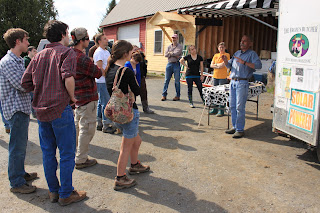With a larger than expected enrollment in my food politics course, taught for the first time in both political science and environmental studies for Spring 2011, one of the challenges was managing the field trip to a relocalizing food system around Hardwick in the Northeast Kingdom. This is primarily because, in northern Vermont, spring and planting come late. Some farms can start during the post winter "mud season" if they have greenhouses. But snow can stay on the ground well into April. As well, more than 30 students enrolled in the class this year, which meant we had to have two trips so that we wouldn't overwhelm any of the facilities we would be visiting, and to give students ample time at each site.

The photo essay below combines images from the first trip in April and the second, as the semester closed in early May.
The farms and business in and around Hardwick offer a unique learning experience. They have hosted tours for academics and community leaders from across the US and around the world, and received national media attention, including Dan Rather Reports and Emeril Legasse's Planet Green series. Local author Ben Hewitt wrote "The Town that Food Saved" about the relocalization of production and markets in the Hardwick area. The area is most noted for the network of mutually supportive farm related businesses that build on the practices of the past, including the generations of dairy farming families and the "back to the land" generation of organic farmers who arrived in the area in the 1970s.
Charlie Emers of Patchwork Farm demonstrates the art of heating an oven for baking bread.
------------------------------------
At Pete's Greens in Craftsbury, students joined proprietor Pete Johnson (pointing on left) for a tour of the the greenhouses heated with discarded cooking oil, and visited the fields in May with Tim Fishburne.
Andrew Meyer (below right) introduces students to Vermont Natural Coatings in Hardwick, which makes wood finishes from whey, a milk byproduct in the process of making cheese.






Sterling College is a small program in Craftsbury Common, combining the benefits of a 4 year college with an onsite working farm. Above, students visit the barn, and below, on the right, Tim Patterson gives us a tour of the farm, on a picturesque hilltop.





Nancy and Helm Nottermann, with their son Ben, operate Snug Valley Farm, where they raise male Holsteins - born on dairy farms - as beef cattle. Before feeding the calves, students had to cover their shoes with plastic to make sure they didn't bring any disease into the stalls.









